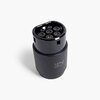STS-134
Active Member
The answer is "no", for however few people that is applicable to.
Do you have any verifiable sources?
You can install our site as a web app on your iOS device by utilizing the Add to Home Screen feature in Safari. Please see this thread for more details on this.
Note: This feature may not be available in some browsers.
The answer is "no", for however few people that is applicable to.
Do you have any verifiable sources?
Wait so you haven't proven the negative then, but you say the answer is no? Huh? Why don't you just say "I am not sure" or just not reply?Proving a negative is hard.
Can you prove that Big Foot doesn't exist?
I lost the plot.Wait so you haven't proven the negative then, but you say the answer is no? Huh? Why don't you just say "I am not sure" or just not reply?
Remember, also, that the SAE J-1772 committee, originally was trying to limit charging to 16 amps (~3.3kW). This was driven by GM's push to require an ICE for any long distance driving, ie the Volt.
Unfortunately, all I have is recollection of the word of folks who were at the standards meetings in the late 2000's. Note that obstructionists at standards meetings seldom leave a lot of written evidence.If you have a verifiable source for that claim I’d love to see it….
Yeah, I should have gotten one of those AVCON-to-J1772 adapter boxes that I think Ron Freund was building at EAA. We had AVCON charging cables and even an old small paddle inductive charger at the Sun Microsystems campus in Santa Clara where I was working back in the early 2010s. . Instead, I settled for sharing 120V outdoor outlets with too many other people. After 2-3 years they put in ChargePoint units.I used the AVCONS quite a bit in the early Roadster days in California with the AVCON-to-NEMA 14-50 adapter from the EAA.
If I’m was new model 3 using CCS2, how can I use with GB/T?
Any one knew it?
Just updated an OP footnote with information about the Tesla-Korea CCS1 adapter--i.e., its triumphant introduction (through the back-door) into North America. A change to the Tesla Adapter chart itself is warranted.
That seems to be only for legacy S/X with the Custom Type 2 plug.(Translations made using Google.)
- GB/T-to-CCS2 adapter (for DC charging while traveling) (用于旅途中的直流充电)
That seems to be only for legacy S/X with the Custom Type 2 plug.
Nothing DC for HK 3/Y with CCS2? Just the AC Type 2 adapter
 +
+  = SUCCESS (adapter fits physically and provides AC power through upper portion of CCS2-port)
= SUCCESS (adapter fits physically and provides AC power through upper portion of CCS2-port) +
+  = FAILURE (fits, but DC power cannot pass through upper portion of CCS2-port)
= FAILURE (fits, but DC power cannot pass through upper portion of CCS2-port) +
+  = SUCCESS (fits and provides AC power through Type 2-port)
= SUCCESS (fits and provides AC power through Type 2-port) +
+  = SUCCESS (fits and provides DC power through Type 2-port)
= SUCCESS (fits and provides DC power through Type 2-port)The best we can hope for is unified per continent. We are already too far along, where different large regions of the world have established infrastructure and plug types, where Type1 and Type2 are totally fine for where they are and are not going to change.Anyone working on a unified connector?
And yet we have a dozen versions of USB plugs and jacks.The best we can hope for is unified per continent. We are already too far along, where different large regions of the world have established infrastructure and plug types, where Type1 and Type2 are totally fine for where they are and are not going to change.
The next generation of connector will likely be unified. Think mobile 3G (UMTS vs EVDO which was never resolved) and it wasn't until a new generation of mobile standards (4G LTE) that everything converged.The best we can hope for is unified per continent. We are already too far along, where different large regions of the world have established infrastructure and plug types, where Type1 and Type2 are totally fine for where they are and are not going to change.
There's generally a desire to make things backwards compatible, up until the point where you have to change them so much that you might as well just throw everything out and start over. When we have a need for multi megawatt charging, none of the old stuff will work, no amount of re-engineering the pins will make the connectors not melt, etc. At that point, people will just toss out the old stuff and start over, and there will be a set of adapters to get the old cars to work with the new standards. The same thing happened with NTSC (made to be backwards compatible with the old black and white TV) to ATSC (different enough that they just started over and gave anyone who wanted to keep using an old TV a converter box).I find it fascinating how many people are wanting to equate communication standards, which have to do with very fine timing and ever-increasing speed improvements, to simple energy delivery, as if they are going to behave the same way.
Exactly.There's generally a desire to make things backwards compatible, up until the point where you have to change them so much that you might as well just throw everything out and start over. When we have a need for multi megawatt charging, none of the old stuff will work, no amount of re-engineering the pins will make the connectors not melt, etc. At that point, people will just toss out the old stuff and start over, and there will be a set of adapters to get the old cars to work with the new standards. The same thing happened with NTSC (made to be backwards compatible with the old black and white TV) to ATSC (different enough that they just started over and gave anyone who wanted to keep using an old TV a converter box).


